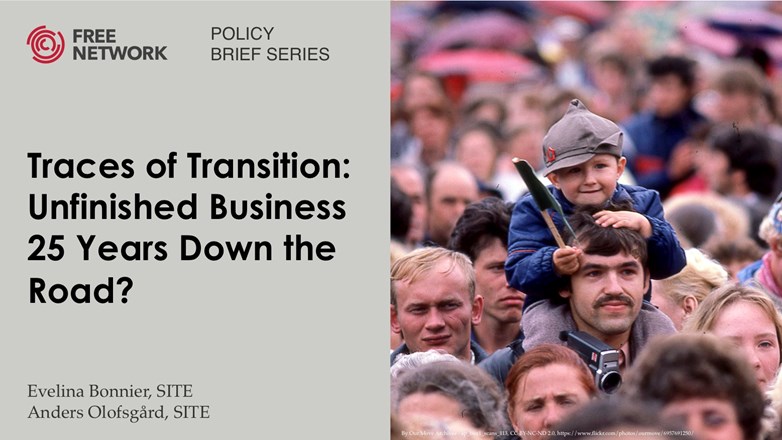Traces of transition: Unfinished business 25 years down the road?
This year marks the 25-year anniversary of the breakup of the Soviet Union and the beginning of a transition period, which for some countries remains far from completed. While several Central and Eastern European countries (CEEC) made substantial progress early on and have managed to maintain that momentum until today, the countries in the Commonwealth of Independent States (CIS) remain far from the ideal of a market economy, and also lag behind on most indicators of political, judicial and social progress. This policy brief reports on a discussion on the unfinished business of transition held during a full day conference at the Stockholm School of Economics on May 27, 2016. The event was organized jointly by the Stockholm Institute of Transition Economics (SITE) and the Swedish Ministry for Foreign Affairs, and was the sixth installment of SITE Development Day – a yearly development policy conference.
A region at a crossroads?
25 years have passed since the countries of the former Soviet Union embarked on a historic transition from communism to market economy and democracy. While all transition countries went through a turbulent initial period of high inflation and large output declines, the depth and length of these recessions varied widely across the region and have resulted in income differences that remain until today. Some explanations behind these varied results include initial conditions, external factors and geographic location, but also the speed and extent to which reforms were implemented early on were critical to outcomes. Countries that took on a rapid and bold reform process were rewarded with a faster recovery and income convergence, whereas countries that postponed reforms ended up with a much longer and deeper initial recession and have seen very little income convergence with Western Europe.
The prospect of EU membership is another factor that proved to be a powerful catalyst for reform and upgrading of institutional frameworks. The 10 countries that joined the EU are today, on average, performing better than the non-EU transition countries in basically any indicator of development including GDP per capita, life expectancy, political rights and civil liberties. Even if some of the non-EU countries initially had the political will to reform and started off on an ambitious transition path, the momentum was eventually lost. In Russia, the increasing oil prices of the 2000s brought enormous government revenues that enabled the country to grow without implementing further market reforms, and have effectively led to a situation of no political competition. Ukraine, on the other hand, has changed government 17 times in the past 25 years, and even if the parliament appears to be functioning, very few of the passed laws and suggested reforms have actually been implemented.
Evidently, economic transition takes time and was harder than many initially expected. In some areas of reform, such as liberalization of prices, trade and the exchange rate, progress could be achieved relatively fast. However, in other crucial areas of reform and institution building progress has been slower and more diverse. Private sector development is perhaps the area where the transition countries differ the most. Large-scale privatization remains to be completed in many countries in the CIS. In Belarus, even small-scale privatization has been slow. For the transition countries that were early with large-scale privatization, the current challenges of private sector development are different: As production moves closer to the world technology frontier, competition intensifies and innovation and human capital development become key to survival. These transformational pressures require strong institutions, and a business environment that rewards education and risk taking. It becomes even more important that financial sectors are functioning, that the education system delivers, property rights are protected, regulations are predictable and moderated, and that corruption and crime are under control. While the scale of these challenges differ widely across the region, the need for institutional reforms that reduce inefficiencies and increase returns on private investments and savings, are shared by many.
To increase economic growth and to converge towards Western Europe, the key challenges are to both increase productivity and factor input into production. This involves raising the employment rate, achieving higher labor productivity, and increasing the capital stock per capita. The region’s changing demography, due to lower fertility rates and rebounding life expectancy rates, will increase already high pressures on pension systems, healthcare spending and social assistance. Moreover, the capital stock per capita in a typical transition country is only about a third of that in Western Europe, with particularly wide gaps in terms of investment in infrastructure.
Unlocking human potential: gender in the region
Regardless of how well a country does on average, it also matters how these achievements are distributed among the population. A relatively underexplored aspect of transition is to which extent it has affected men and women differentially. Given the socialist system’s provision of universal access to education and healthcare, and great emphasis on labor market participation for both women and men, these countries rank fairly well in gender inequality indices compared to countries at similar levels of GDP outside the region when the transition process started. Nonetheless, these societies were and have remained predominantly patriarchal. During the last 25 years, most of these countries have only seen a small reduction in the gender wage gap, some even an increase. Several countries have seen increased gender segregation on the labor market, and have implemented “protective” laws that in reality are discriminatory as they for example prohibit women from working in certain occupations, or indirectly lock out mothers from the labor market.
Furthermore, many of the obstacles experienced by small and medium-sized enterprises (SMEs) are more severe for women than for men. Female entrepreneurs in the Eastern Partnership (EaP) countries have less access to external financing, business training and affordable and qualified business support than their male counterparts. While the free trade agreements, DCFTAs, between the EU and Ukraine, Georgia, and Moldova, respectively, have the potential to bring long-term benefits especially for women, these will only be realized if the DCFTAs are fully implemented and gender inequalities are simultaneously addressed. Women constitute a large percentage of the employees in the areas that are the most likely to benefit from the DCFTAs, but stand the risk of being held back by societal attitudes and gender stereotypes. In order to better evaluate and study how these issues develop, gendered-segregated data need to be made available to academics, professionals and the general public.
Conclusion
Looking back 25 years, given the stakes involved, things could have gotten much worse. Even so, for the CIS countries progress has been uneven and disappointing and many of the countries are still struggling with the same challenges they faced in the 1990’s: weak institutions, slow productivity growth, corruption and state capture. Meanwhile, the current migration situation in Europe has revealed that even the institutional development towards democracy, free press and judicial independence in several of the CEEC countries cannot be taken for granted. The transition process is thus far from complete, and the lessons from the economics of transition literature are still highly relevant.
Participants at the conference
- Irina Alkhovka, Gender Perspectives.
- Bas Bakker, IMF.
- Torbjörn Becker, SITE.
- Erik Berglöf, Institute of Global Affairs, LSE.
- Kateryna Bornukova, Belarusian Research and Outreach Center.
- Anne Boschini, Stockholm University.
- Irina Denisova, New Economic School.
- Stefan Gullgren, Ministry for Foreign Affairs.
- Elsa Håstad, Sida.
- Eric Livny, International School of Economics.
- Michal Myck, Centre for Economic Analysis.
- Tymofiy Mylovanov, Kyiv School of Economics.
- Olena Nizalova, University of Kent.
- Heinz Sjögren, Swedish Chamber of Commerce for Russia and CIS.
- Andrea Spear, Independent consultant.
- Oscar Stenström, Ministry for Foreign Affairs.
- Natalya Volchkova, Centre for Economic and Financial Research.




